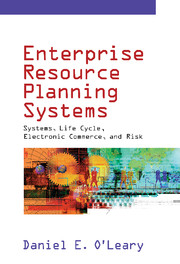Book contents
- Frontmatter
- Contents
- Acknowledgments
- PART ONE INTRODUCTION AND BACKGROUND
- PART TWO ERP SYSTEMS
- PART THREE ERP LIFE CYCLE
- 7 Deciding to Go ERP
- 8 Choosing an ERP System
- 9 Designing ERP Systems: Should Business Processes or ERP Software Be Changed?
- 10 Designing ERP Systems: Choosing Standard Models, Artifacts, and Processes
- 11 Implementing ERP Systems: Big Bang versus Phased
- 12 After Going Live
- 13 Training
- PART FOUR ELECTRONIC COMMERCE AND RISK
- Index
8 - Choosing an ERP System
from PART THREE - ERP LIFE CYCLE
Published online by Cambridge University Press: 05 June 2012
- Frontmatter
- Contents
- Acknowledgments
- PART ONE INTRODUCTION AND BACKGROUND
- PART TWO ERP SYSTEMS
- PART THREE ERP LIFE CYCLE
- 7 Deciding to Go ERP
- 8 Choosing an ERP System
- 9 Designing ERP Systems: Should Business Processes or ERP Software Be Changed?
- 10 Designing ERP Systems: Choosing Standard Models, Artifacts, and Processes
- 11 Implementing ERP Systems: Big Bang versus Phased
- 12 After Going Live
- 13 Training
- PART FOUR ELECTRONIC COMMERCE AND RISK
- Index
Summary
This chapter examines how firms choose between different ERP systems. Two primary approaches are used to guide ERP choice: requirements analysis and gap analysis. This chapter defines these approaches and examines the advantages and disadvantages of each, and it briefly discusses an alternative approach. In addition, this chapter examines the assumptions behind requirements analysis and gap analysis as well as some limitations of these two processes. Also discussed are two companies that have mitigated these limitations in their evaluation of ERP software by going beyond requirements and gap analyses. Finally, this chapter summarizes the shortcomings of broader evaluation approaches.
Requirements Analysis
Requirements analysis is a review of system requirements for organizational models, artifacts, and processes (MAPs). In some cases requirements are cataloged as to their importance – for example, required or optional, or ranked (say) from 1 to 3. Requirements are then summarized in a requirements document (request for proposal, or RFP) that is provided to different vendors. The organization uses that set of requirements to judge how well different pieces of software meet their needs.
How Many Requirements?
Requirements documents can be quite extensive. For example, one company (Firm A) with $40 million in sales produced a document with about 1,000 requirements listed. Timberjack, with over $35 million in sales, listed 1,042 requirements. A much larger and privately held company (Firm B) also had a requirements document with over 1,000 items.
- Type
- Chapter
- Information
- Enterprise Resource Planning SystemsSystems, Life Cycle, Electronic Commerce, and Risk, pp. 102 - 116Publisher: Cambridge University PressPrint publication year: 2000

